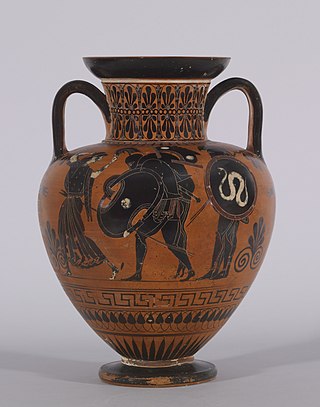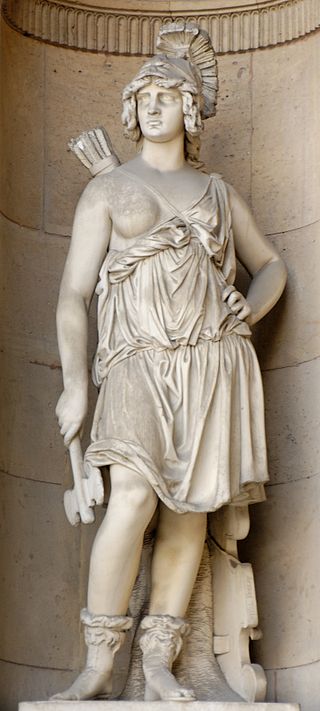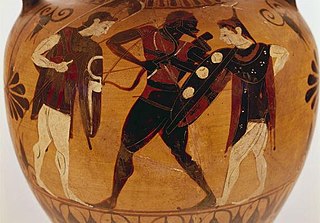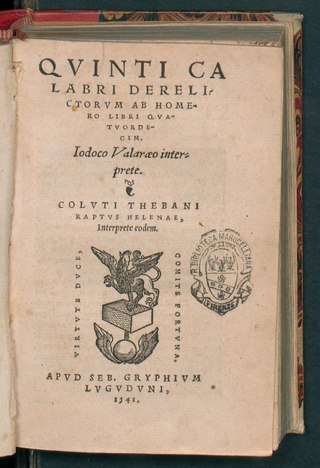
In Greek mythology, Achilles or Achilleus was a hero of the Trojan War who was known as being the greatest of all the Greek warriors. A central character in Homer's Iliad, he was the son of the Nereid Thetis and Peleus, king of Phthia and famous Argonaut. Achilles was raised in Phthia along with his childhood companion Patroclus and received his education by the centaur Chiron. In the Iliad, he is presented as the commander of the mythical tribe of the Myrmidons.

Ajax or Aias is a Greek mythological hero, the son of King Telamon and Periboea, and the half-brother of Teucer. He plays an important role in the Trojan War, and is portrayed as a towering figure and a warrior of great courage in Homer's Iliad and in the Epic Cycle, a series of epic poems about the Trojan War, being second only to Achilles among Greek heroes of the war. He is also referred to as "Telamonian Ajax", "Greater Ajax", or "Ajax the Great", which distinguishes him from Ajax, son of Oileus, also known as Ajax the Lesser.

In Greek mythology, Hector is a Trojan prince, hero and the greatest warrior for Troy during the Trojan War. He is a major character in Homer's Iliad, where he leads the Trojans and their allies in the defense of Troy, killing countless Greek warriors. He is ultimately killed in single combat by Achilles, who later drags his dead body around the city of Troy behind his chariot.

In Greek mythology, Priam was the legendary and last king of Troy during the Trojan War. He was the son of Laomedon. His many children included notable characters such as Hector, Paris, and Cassandra.

Penthesilea was an Amazonian queen in Greek mythology, the daughter of Ares and Otrera and the sister of Hippolyta, Antiope and Melanippe. She assisted Troy in the Trojan War, during which she was killed by Achilles or Neoptolemus. The asteroid 271 Penthesilea, discovered in 1887, was named in her honor.

Diomedes or Diomede is a hero in Greek mythology, known for his participation in the Trojan War.

In Greek mythology, Patroclus was a hero of the Trojan War and an important character in Homer's Iliad. He is widely known for being the childhood friend and close wartime companion of the hero Achilles. When the tide of the war turned against the Achaeans, Patroclus, disguised as Achilles and defying his orders to retreat in time, led the Myrmidons in battle against the Trojans and was eventually killed by the Trojan prince, Hector. Enraged by Patroclus' death, Achilles ended his refusal to fight, resulting in significant Greek victories.

Troy is a 2004 epic historical war film directed by Wolfgang Petersen and written by David Benioff. Produced by units in Malta, Mexico and Britain's Shepperton Studios, the film features an ensemble cast led by Brad Pitt, Eric Bana, Sean Bean and Orlando Bloom. It is loosely based on Homer's Iliad in its narration of the entire story of the decade-long Trojan War—condensed into little more than a couple of weeks, rather than just the quarrel between Achilles and Agamemnon in the ninth year. Achilles leads his Myrmidons along with the rest of the Greek army invading the historical city of Troy, defended by Hector's Trojan army. The end of the film is not taken from the Iliad, but rather from Quintus Smyrnaeus's Posthomerica, as the Iliad concludes with Hector's death and funeral.

In Greek mythology, Euphorbus was a Trojan hero during the Trojan War.

Troilus is a legendary character associated with the story of the Trojan War. The first surviving reference to him is in Homer's Iliad, composed in the late 8th century BCE.

The Aethiopis, also spelled Aithiopis, is a lost epic of ancient Greek literature. It was one of the Epic Cycle, that is, the Trojan cycle, which told the entire history of the Trojan War in epic verse. The story of the Aethiopis comes chronologically immediately after that of the Homeric Iliad, and is followed by that of the Little Iliad. The Aethiopis was sometimes attributed by ancient writers to Arctinus of Miletus. The poem comprised five books of verse in dactylic hexameter.

In Greek mythology, Memnon was a king of Aethiopia and son of Tithonus and Eos. As a warrior he was considered to be almost Achilles' equal in skill. During the Trojan War, he brought an army to Troy's defense and killed Antilochus, Nestor's son, during a fierce battle. Nestor challenged Memnon to a fight, but Memnon refused, being there was little honor in killing the aged man. Nestor then pleaded with Achilles to avenge his son's death. Despite warnings that soon after Memnon fell so too would Achilles, the two men fought. Memnon drew blood from Achilles, but Achilles drove his spear through Memnon's chest, sending the Aethiopian army running. The death of Memnon echoes that of Hector, another defender of Troy whom Achilles also killed out of revenge for a fallen comrade, Patroclus.

The relationship between Achilles and Patroclus is a key element of the stories associated with the Trojan War. In the Iliad, Homer describes a deep and meaningful relationship between Achilles and Patroclus, where Achilles is tender toward Patroclus, but callous and arrogant toward others. Its exact nature—whether homosexual, a non-sexual deep friendship, or something else entirely—has been a subject of dispute in both the Classical period and modern times. Homer never explicitly casts the two as lovers, but they were depicted as lovers in the archaic and classical periods of Greek literature, particularly in the works of Aeschylus, Aeschines and Plato.

The Posthomerica is an epic poem in Greek hexameter verse by Quintus of Smyrna. Probably written in the 3rd century AD, it tells the story of the Trojan War, between the death of Hector and the fall of Ilium. The poem is an abridgement of the epic poems Aethiopis and Iliou Persis by Arctinus of Miletus and the Little Iliad by Lesches, all now-lost poems of the Epic Cycle.

Narrative art is art that tells a story, either as a moment in an ongoing story or as a sequence of events unfolding over time. Some of the earliest evidence of human art suggests that people told stories with pictures. Although there are some common features to all narrative art, different cultures have developed idiosyncratic ways to discern narrative action from pictures.

The Berlin Foundry Cup is a red-figure kylix from the early 5th century BC. It is the name vase of the Attic vase painter known conventionally as the Foundry Painter. Its most striking feature is the exterior depiction of activities in an Athenian bronze workshop or foundry. It is an important source on ancient Greek metal-working technology.

The Iliad is one of two major ancient Greek epic poems attributed to Homer. It is one of the oldest extant works of literature still widely read by modern audiences. As with the Odyssey, the poem is divided into 24 books and was written in dactylic hexameter. It contains 15,693 lines in its most widely accepted version. Set towards the end of the Trojan War, a ten-year siege of the city of Troy by a coalition of Mycenaean Greek states, the poem depicts significant events in the siege's final weeks. In particular, it depicts a fierce quarrel between King Agamemnon and a celebrated warrior, Achilles. It is a central part of the Epic Cycle. The Iliad is often regarded as the first substantial piece of European literature.

The Monteleone chariot is an Etruscan chariot dated to c. 530 BC, considered one of the world's great archaeological finds. It was originally uncovered at Monteleone di Spoleto, Umbria, Italy, and is currently a major attraction in the collection of the Metropolitan Museum of Art in New York City.

The Amphora of Hermonax in Würzburg is a neck amphora which was made by the early classical Attic vase painter Hermonax in the red figure style of Greek vase painting around 450 BC. The amphora was found in an Etruscan grave in Vulci. Originally kept in the Feoli collection, it now belongs to the antiquity collection of the Martin von Wagner Museum in Würzburg, where it is on display with a lid which probably does not belong to it.

Troilus and Cressida is a play by William Shakespeare, probably written in 1602.




















